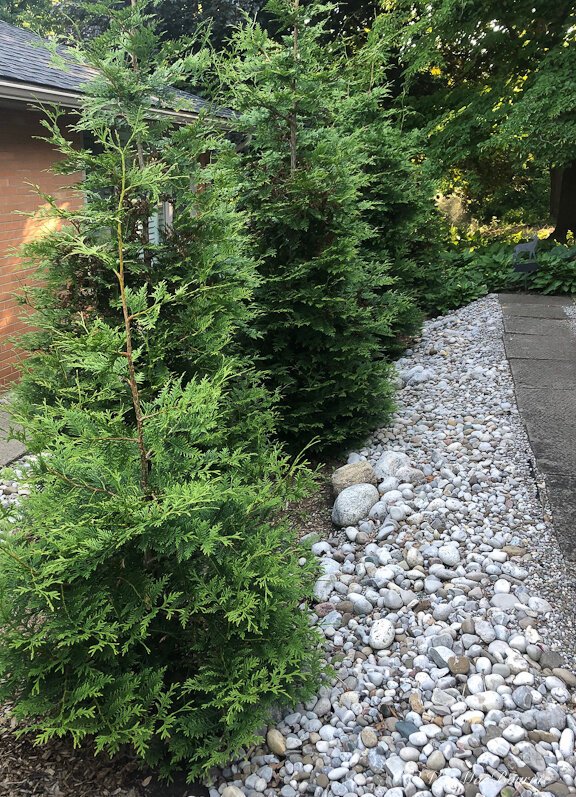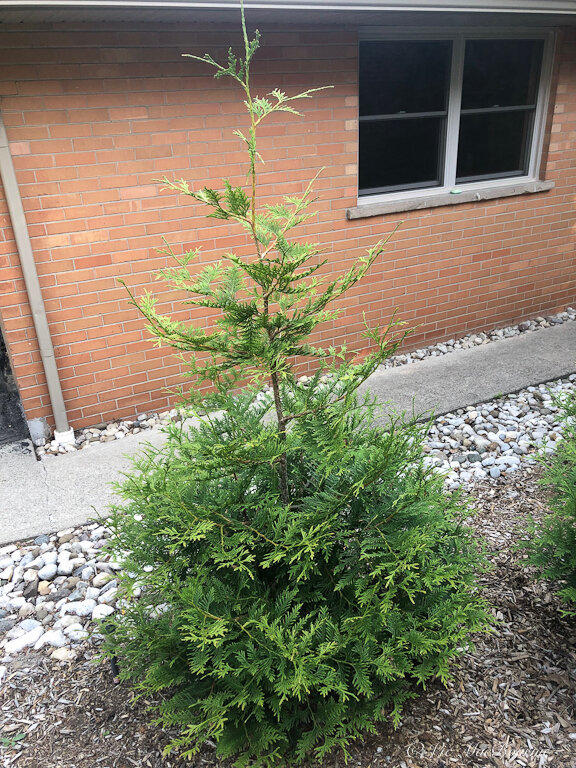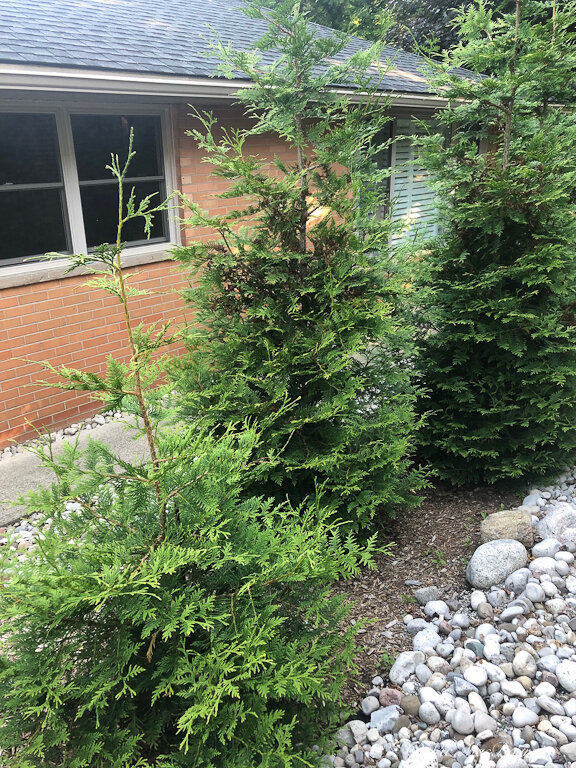Green Giant cedars: Fast growing arborvitae ideal for privacy
Green Giant arborvitae create year-round privacy fast
Is there room anymore in our gardens for big? Big trees, big shrubs, big boulders – BIG, Bold colour and plantings.
Well, make room for the Green Giant. Thuya Green Giant, Green Giant Arborvitae, call it what you wish. These are big, bold evergreens in your garden and we all need more of these type of statements in our woodland gardens.
Want privacy? This is how you get it. And not just in the summer. Green Giants provide year-round privacy and they do it quickly. There is no need to wait years to eliminate that eyesore or bothersome neighbour.
It seems like everything is miniaturized in garden centres these days, aimed more at timid gardeners who have been convinced that their properties are too small to handle any larger-sized trees, plants and shrubs.
Well, Green Giants are here to prove that big and bold is beautiful. If there was a bean stock, Thuya Green Giant would outgrow it and look fantastic doing it.
Let’s take a closer look at these evergreens – also known as Green Giant Arborvitae – that grow big fast, provide the perfect evergreen screen when you need it in a hurry, have a beautiful dense deep green colour and a natural loose habit that allows them to fit into a natural woodland setting. They are shelter for wildlife during our cold winters, a nesting spot for birds in spring and summer and best of all, deer leave them alone. That’s not all, Green Giants are not bothered by insects or disease and can stand up to most adverse weather situations.
A cedar deer don’t like
Yes, you read that right. A cedar that deer, including those all around our property, will not devour in a day.
Thuja Green Giants (Thuja Standishii Plicata ‘Green Giant’) did not earn their names from being timid.
These things can grow to enormous heights (40-60 ft) with a width of between 12-20 ft. And they don’t waste time doing it putting on 3 to 5 feet of growth a season when they’re happy.
These pyramidal shaped cedars grow in zones 5-7 and are an excellent disease-free substitute for other plants like Western Red Cedar or Leyland Cypress. Spring growth emerges a fresh lighter green and winter colour is a darker, bronzer shade.
These Green Giants form the perfect natural privacy screen between our neighbours and us, creating a wall of soft evergreen that even the birds enjoy.
They can grow happily in full sun to partial shade, in acidic or alkaline soil and are not fussy about whether it’s sandy or heavy clay.
So, in other words, these things will grow just about anywhere, in any soil conditions.
Use them as a specimen tree and let them be free to grow into their natural shape in your yard, or plant them together every 5 to 6 feet to create a privacy barrier to your property from neighbours, unsightly objects and busy streets. Their dense foliage will go a long way to not only block out the view but reduce noise and act as a possible wind-break.
Your choice to grow as a specimen or a privacy screen, but I always lean to allowing a tree to grow into its natural shape.
Green Giants on our property
In fact, the pictures above show the 8 Green Giants my neighbour and I planted between our properties last summer.
The results are impressive.
We chose the Green Giants to replace an unsightly, overgrown deciduous hedge that had long past its prime. They were planted close together (about 6 feet) and staggered them to give the foliage more room to grow and spread out.
The result is stunning. The growth rate is spectacular.
The original 5-foot cedars grew two to three feet the first year we planted them and they are already forming a solid screen between us.
I’m hoping we can grow them more as large specimens with minimum pruning but time will dictate that. If they get too big width-wise, we could always remove a couple to give them more room to grow naturally.
This spring, I have noticed that the birds have discovered it and I think are beginning to take up residence in their lovely dense foliage.
Of particular note to those looking to save some money. Two of the eight trees we planted were much smaller than the other six trees. The nursery ran out of the larger trees, so we purchased two of the smaller, less expensive cedars.
Buy small and save big on Green Giants
As an experiment, we put them up front where they will receive more direct evening sun than the larger specimens. We expected the smaller ones to perform better than the larger specimens and eventually catch up to the point where it would be hard to recognize any real difference between them.
We were shocked to see the smaller cedars almost catch up to their larger neighbours in one season of growth. I imagine that by the end of the second year, it will be hard to distinguish between the smaller cedars and the larger ones.
So, if you are looking to save money as well as make the planting procedure much easier with the smaller root balls, consider going with the smaller versions of the cedars at the nursery. The growth rate is so strong on these trees that you will not have to wait long before they begin filling in and meeting your goals.
Emerald cedars vs Green Giants
I am going to go out on a limb here and just say it – why are so many gardeners choosing Emerald Green cedars (Thuja occidentalis ‘Smaragd’) over Green Giants or other, more natural looking, cedars?
I believe it all goes back to what the nurseries are offering and the push toward a smaller-scaled landscape because (in my mind) it certainly is not because Emerald Green cedars are nice.
They may look nice on the nursery lot with their bright green foliage but, to my eye, they don’t look appropriate in most landscapes. Hardy to zone 3b and growing to a height of only 12 feet with a spread of only about 4 feet, I can see why homeowners are originally attracted to these trees.
But the narrowness and upright, extremely dense foliage and brighter green colour just gives these a far too stiff and formal look to my liking. They work fine in a more formal setting, but I really don’t think they belong in a more natural setting and certainly not in a woodland garden.
My biggest problem with them is that, because the growth is so tight, the branches don’t intermingle well together and when they do, they often die off because of a lack of sun. The result, if any pruning is done to them, are ugly brown dead areas.
Is it obvious that I don’t like them much?
Just to add to my dislike, these things don’t live long at all averaging only about 30 years.
Consider the Black cedar or white cedars if deer are not an issue
My first choice in cedars is by far Black cedars (Thuja occidentalis ‘Nigra’). These are very much like Green Giants but are described as a selection of a native North American species. The Black cedars’ natural foliage that is a dense, dark and green with a little bit of a dusty-green look is even nicer than the Green Giants’ also impressive foliage.
A friend of mine recently put in a row of the black cedars along a fence and the result is stunning.
Black cedars grow fast to about 20 feet with a 7 foot spread, but not as quickly as Green Giants. The Nigra takes a pruning well and likes at least some sun over the course of the day.
The only reason my neighbour and I chose Green Giants over Black cedars is the fact that deer would have devastated the Black cedars within a week of planting them.
Following black cedars, our native swamp cedars, (Thuja Occidentalis) commonly known as the Arbor Vitae, Arborvitae, Eastern Arborvitae, Eastern White-cedar, Northern White Cedar, Northern White-cedar, Swamp-cedar, would be my next choice. These are often sold at the nurseries in spring as bare rooted cedars. They look spindly and not very attractive upon purchase, but are very cheap, grow fast and eventually thicken up to create an almost impenetrable privacy wall or impressive specimens. Under the right conditions, these are also very long lived.
These white cedars are perfect, accept they are high on the list of favourite food for our local deer population.
Again, Green Giants are of no interest to deer. My neighbour and I went through an entire winter where the deer left our Green Giants alone, and we did not even spray them with any deer repellent.
Impressive to say the least.
Why don’t I like Emerald Green cedars. They grow too tightly, too slowly and don’t provide the privacy that Green Giants or other more ‘loose-growing cedars’ can provide homeowners. In addition, their bright green foliage stands out in the landscape too much, in my mind. Rather than forming a perfect dark background, the Emeralds want to take centre stage.
Their biggest problem, as I mentioned earlier, is that because of their tight growth habit, if they begin to grow together like we want them to so they provide privacy, they will die off where they touch because of a lack of sun. If enough space is left between them to allow for their mature growth, they fail to provide the wall of privacy that the homeowner originally bought them for.
I know that landscapers are using them a lot and nurseries are pushing them to homeowners as the perfect hedging material, but consider their drawbacks before you go ahead and plant them.
One of our neighbours has them along their driveway, and every year they have to wrap them in burlap to stop the deer from snacking on them as well as protect them from cold winds. That’s not something I’m interested in doing, but if you are okay with it, by all means plant them.
Many homeowners like Emerald cedars, I happen to not be one of them. I’m definitely biased, so if you like them, plant them.
Green Giants are far from perfect
This is not to say that Green Giants are the perfect tree.
Anything that grows as fast as Green Giants come with their own problems. Silver maples, poplars and birch trees are good examples of fast-growing trees that, although they have their benefits, also come with big problems.
The faster a tree grows, generally the weaker its wood.
Why does that matter?
It matters most in severe weather when heavy snows or high winds can snap branches off. Whether they hit your home or just leave the trees unsightly, it’s never a good thing to have branches breaking on your trees.
In the case of cedars, it’s not uncommon for the tree branches to split resulting in either complete destruction of the tree or severe disfiguring.
This winter we did have a severe late winter snowstorm that left our cedars bent over by the heavy snow. I went out with a broom to clear some of the snow knowing that the trees can suffer damage in these situations. Turned out that they bounced back immediately and came through the storm with flying colours.
Another problem with fast growing trees is that they tend not to have long lives. Green Giants are given about a 40-year life span. I’m sure that in the right conditions they can live much longer but on average that is what you can expect.
The sheer size of these fast-growing trees is obviously a problem for some people. If you are young, you might want to consider the full mature height of these trees. They get large and can take up a lot of room if they are allowed to grow naturally. That can be a good or bad thing depending on the size of your yard and how you plan to use the tree(s) in your landscape.
My neighbour and I are, let’s say well past being called ‘young’ so having a fast-growing tree is perfect for us.
Let’s just say we are not too worried about either outliving the trees or about them getting to big in our lifetime. Your situation might be different. If so, a different type of tree might be a better choice, but don’t immediately write off a fast growing tree like the Green Giants.
If you need a quick cover that looks great, it’s hard to beat the vigour and beauty of the Green Giant cedar.
As an affiliate marketer with Amazon or other marketing companies, I earn money from qualifying purchases.




